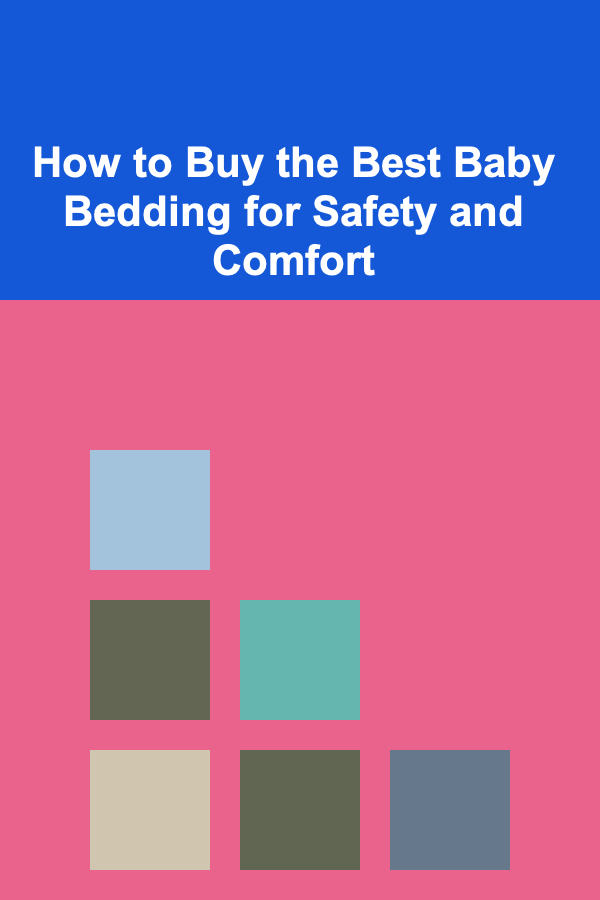
How to Buy the Best Baby Bedding for Safety and Comfort
ebook include PDF & Audio bundle (Micro Guide)
$12.99$5.99
Limited Time Offer! Order within the next:

When it comes to your baby's sleep, comfort and safety are the top priorities. One of the most essential components of a baby's sleep environment is their bedding. But with so many options available, choosing the right baby bedding can feel overwhelming. This guide will help you make informed decisions on purchasing the best baby bedding to ensure both safety and comfort for your little one.
Understand the Importance of Baby Bedding Safety
The primary concern when choosing baby bedding is safety. Babies, especially newborns, are vulnerable to risks such as suffocation, overheating, and Sudden Infant Death Syndrome (SIDS). Choosing the right bedding not only ensures that your baby sleeps comfortably but also minimizes these risks.
Key Safety Considerations:
- Avoid Loose Bedding: Loose blankets, pillows, or stuffed animals can be a suffocation hazard. The American Academy of Pediatrics (AAP) recommends that babies sleep in a crib with a firm mattress and no soft bedding.
- Opt for Breathable Fabrics: Overheating is a significant risk for babies. Ensure that the fabrics you choose for your baby's bedding are breathable and help regulate temperature.
- Avoid Bumpers and Pillows: While crib bumpers might seem like a nice decorative touch, they can pose serious safety risks. The AAP advises against using crib bumpers because of the suffocation hazard they present.
Choose a Firm, Safe Mattress
The mattress is the foundation of your baby's crib, and it plays a crucial role in both safety and comfort. A firm mattress is essential for reducing the risk of suffocation and Sudden Infant Death Syndrome (SIDS). When choosing a mattress, keep these guidelines in mind:
Features of a Safe Mattress:
- Firmness: A firm mattress helps reduce the risk of suffocation. It should not conform to the shape of your baby's body or leave indentations. A firm mattress helps to keep your baby in a safe, stable sleep position.
- Size: Ensure the mattress fits snugly in the crib without any gaps between the mattress and the crib frame. Gaps could potentially lead to a suffocation hazard if your baby gets stuck.
- Non-toxic Materials: Look for mattresses made from natural, non-toxic materials. Babies spend a lot of time in their cribs, so it's important that the materials they come into contact with are free from harmful chemicals.
Types of Baby Mattresses:
- Innerspring Mattresses: These mattresses offer a good combination of support and breathability, making them a popular choice for parents.
- Foam Mattresses: These are lightweight, easy to handle, and often more affordable, but ensure that the foam is firm enough to provide adequate support.
- Organic Mattresses: If you're looking for an eco-friendly option, organic mattresses made from natural materials like organic cotton or wool can provide a safe and breathable option for your baby.
Select Baby Bedding Made of Safe, Comfortable Fabrics
Choosing the right fabric is crucial for both comfort and safety. The right fabrics will keep your baby cozy while allowing proper airflow to prevent overheating.
Fabric Safety and Comfort Tips:
- Organic Cotton: Cotton is breathable, soft, and gentle on your baby's skin. Organic cotton, in particular, is grown without pesticides and chemicals, making it a safer option for sensitive skin.
- Muslin: Muslin is lightweight, breathable, and soft, making it a great option for warmer climates. It's also durable and softens with each wash.
- Bamboo: Bamboo fabric is hypoallergenic, moisture-wicking, and breathable. It's also naturally antimicrobial, which makes it an excellent choice for babies with sensitive skin.
- Avoid Synthetic Fabrics: Synthetic fabrics such as polyester can trap heat and moisture, making your baby uncomfortable and increasing the risk of overheating. Stick to natural, breathable fibers for the safest option.
Additional Tips:
- Softness: Your baby's skin is delicate, so choose fabrics that are soft and smooth to prevent irritation.
- Washing: Choose fabrics that are easy to wash and maintain. Babies are prone to messes, and you'll need bedding that can be washed frequently without losing its softness or integrity.
Opt for a Minimalist Approach to Baby Bedding
Overly adorned or excessive bedding can pose unnecessary risks to your baby's safety. Keep your baby's crib simple and free from unnecessary items that could be potential hazards.
What to Keep in Your Baby's Crib:
- Fitted Sheets: A fitted sheet is essential for comfort and safety. Ensure it's snugly fitted to the mattress and does not slip off or bunch up.
- Lightweight Swaddle or Sleeping Bag: Instead of using blankets, which could pose a suffocation hazard, consider using a lightweight swaddle or a wearable sleeping bag to keep your baby warm.
- Flat Crib Sheet: If you use a flat sheet, make sure it's tucked in tightly to avoid any loose fabric that could pose a risk.
Items to Avoid:
- Bumpers: While crib bumpers may seem like a cute decoration, they increase the risk of suffocation and are not recommended by pediatricians.
- Pillows: Babies do not need pillows before the age of 2. Pillows can cause suffocation or misalignment of the baby's neck and spine.
- Stuffed Animals: Stuffed animals should be kept out of the crib as they can pose a suffocation risk.
Choose Temperature-Regulating Bedding
Babies are especially vulnerable to overheating, which can increase the risk of SIDS. Make sure that the bedding you choose helps to regulate your baby's body temperature.
Temperature-Regulating Fabrics:
- Cotton and Bamboo: Both of these materials are naturally breathable and moisture-wicking, making them ideal for regulating your baby's body temperature.
- Merino Wool: Merino wool is a great option for cooler climates. It's breathable and moisture-wicking and can keep your baby warm without overheating.
- Thermoregulatory Sleepwear: Consider dressing your baby in thermoregulated sleepwear designed for different climates. These sleepwear options are made to help maintain the baby's temperature throughout the night.
Signs of Overheating:
- Sweating: If your baby is sweating or feels hot to the touch, it could be a sign that they are too warm.
- Flushed Skin: If your baby's face or body is flushed or red, they may be overheated.
Look for Easy-to-Clean Bedding
Babies are prone to accidents, from spit-ups to diaper leaks. Easy-to-clean bedding will make your life much simpler and ensure that your baby's sleep environment stays fresh and hygienic.
Tips for Easy Cleaning:
- Machine-Washable: Choose bedding that can be machine-washed and dried. Frequent washing is inevitable, so make sure your baby's bedding can withstand multiple washes.
- Stain-Resistant Fabrics: Some fabrics are naturally stain-resistant or treated to repel stains, making them easier to clean.
- Durability: Look for bedding that will hold up well after multiple washes. High-quality, durable fabrics are key to maintaining both comfort and hygiene.
Consider Style and Aesthetics
While safety and comfort are your top priorities, the aesthetics of your baby's bedding also matter. A calm and serene environment can help your baby sleep better. Choose bedding that fits the overall aesthetic of the nursery while maintaining functionality.
Tips for Choosing a Style:
- Neutral Colors: Soft, neutral colors such as whites, creams, and pastels create a peaceful and soothing environment. These colors are also versatile and can work with any nursery theme.
- Simple Designs: Avoid overly busy patterns or designs that could overstimulate your baby. Subtle patterns, such as stripes, dots, or gentle animal motifs, create a calming atmosphere.
- Coordinated Bedding: If you prefer a coordinated look, many brands offer bedding sets with matching items, such as crib sheets, blankets, and pillowcases, ensuring a cohesive and stylish design.
Conclusion
Choosing the best baby bedding for safety and comfort involves careful consideration of several factors, including fabric choices, mattress safety, temperature regulation, and ease of cleaning. By prioritizing your baby's safety and comfort, and avoiding common hazards like loose bedding and synthetic fabrics, you can create a safe, cozy, and nurturing sleep environment for your little one. Always remember that the simple, minimalistic approach to baby bedding is often the best one. By keeping these tips in mind, you'll be well-equipped to make the best choices for your baby's sleep environment.

How to Get Inspired for the Best Bathroom Makeovers
Read More
How to Integrate Different Tools for a Seamless Automated Workflow
Read More
How to Prevent Noise from Neighbors Using Soundproofing Methods
Read More
How to Use DIY Decorations to Personalize Your Holiday Home
Read More
How to Understand the Different Types of Galaxies
Read More
Exploring the Wonders of Ancient Greece
Read MoreOther Products

How to Get Inspired for the Best Bathroom Makeovers
Read More
How to Integrate Different Tools for a Seamless Automated Workflow
Read More
How to Prevent Noise from Neighbors Using Soundproofing Methods
Read More
How to Use DIY Decorations to Personalize Your Holiday Home
Read More
How to Understand the Different Types of Galaxies
Read More